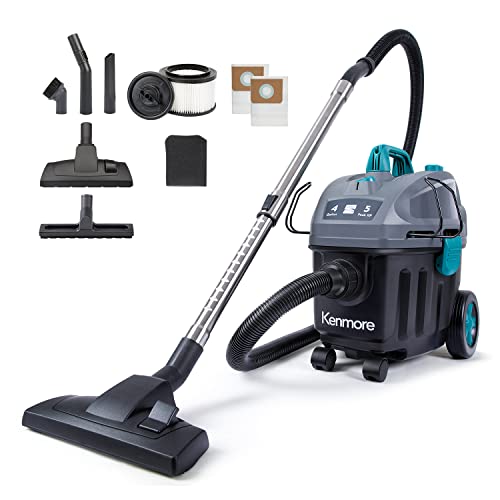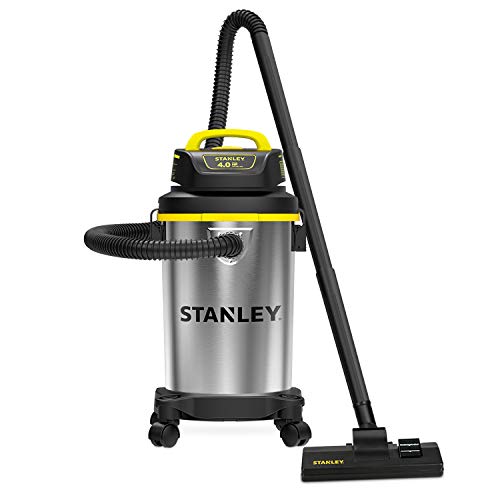If you’re a fan of Wet Dry Vacuums/Shop Vacs you probably already know that they offer the convenience of being able to handle any mess whether it has sand, liquid, hair, or other debris. One of the biggest downsides of Wet Dry Vacuums and most other vacuums is how loud they usually are.

In this article, we’re going to take a look at what wet dry vacuums are and why you might want one. The paragraphs will be clearly labeled, so if you already know what a wet-dry vacuum is you can skip it. Then we’re going to give you some options to help you find the quietest wet dry vacuum on the market today. Let’s dive in!
Our Recommended Quiet Shop-Vacs in 2023
Popular
DeWALT DXV10P 10 gallon Quiet Poly Wet Dry Vacuum
The DXV10P by DeWalt is one of the most popular low-noise shop vacs available today. It can accommodate up to 10 gallons of dry and wet debris. The powerful motor peaks at 5.5 HP, giving it the ability to suction up sawdust, wet concrete, and anything in between.
With rubberized casters, the DXV10P glides seamlessly across all surface types. Users can also activate the blower function, which delivers enough airflow to move large piles of sawdust and debris from your garage workshop. To empty out the DXV10P of any liquids, simply remove the drain plug on the bottom of the unit’s body.
- Sturdy 10 gallon dual-stage wet/dry Vac has quieter operation for clean-up applications....
- Powerful 5.5 peak horsepower motor provides just the amount of suction needed to most any...
Wall Mounted
Vacmaster VWM510
If you want the best wall-mounted shop vac, the Vacmaster VM510 is quite possibly the best option. The 2-stage motor offers both incredibly suction power while also outputting very little noise for a shop vac. It features a 21-foot-long hose and a 20-foot-long power cord, giving users 41 feet of movement from any wall outlet.
Along with your purchase, you’ll receive an assortment of cleaning attachments, including a flexible hose, multiple extension wands, a squeegee and floor brush, as well as a round dust brush for general-purpose cleaning. Also, if you mount it using the included storage rack, there’s a compartment to keep the power cord nice and tidy while in use.
Handheld
DEWALT 20V MAX Wet-Dry Vacuum
DEWALT makes a wide range of wet-dry vacuums, including handheld units like the DCV580H. This unit runs off a 20V MAX battery, which provides up to 15 minutes of nonstop cleaning per charge. The battery is detachable, so if you invest in additional MAX batteries or have any lying around, you can extend your cleaning time significantly.
The handheld wet-dry vac is designed with heavy-duty materials, allowing it to withstand heavy impacts without issue. It can store up to 2 gallons of debris, while a HEPA filter captures 0.3-micron particles up to 99.97% of the time. Please note that the DEWALT DCV580 doesn’t come with a MAX battery or a charger.
- Cordless operation powered by 20V MAX battery.Specific uses:Dual action
- Easily accessible, washable/reusable filter; tap or water rinse to clean
Professional
Festool 574930 CT 26 E HEPA Dust Extractor
Like any product sporting the Festool name, you can expect the 574930 Dust Extractor to perform phenomenally. First of all, it’s a high-powered shop vac that uses turbine technology to enhance airflow for maximum dust collection. As a professional-grade shop vac, it offers the most convenience you can get from a shop vac.
ou can retrofit your 574930 to use compressed air or a Bluetooth module, giving you remote control access to start and stop the shop vac whenever you’re in range. It comes with an 11.25-foot-long hose that’s both crush-proof and antistatic, so there’s minimal risk that a spark will ignite the collected debris.
- Constantly high suction because of the compact high performance turbine
- Smooth suction hose and optimized sys-dock with cord holder and t-loc function for...
How to Choose the Best Shop Vac
Shop vacs are heavy-duty vacuum cleaners, often used in industries such as construction and woodworking. Thanks to their high-powered motors and suction capacity, they can hoover up larger chunks of dirt and debris than a regular household vacuum cleaner can.
These cleaners are sometimes known as bucket vacuums due to their large debris canisters and hose attachments. In addition, they usually come equipped with wheels, allowing them to be easily moved around a construction site or workshop.
Shop vacs will hoover up nails, screws, pieces of metal, sawdust, plaster, woodchips, and smaller fragments. Some models, known as wet/dry shop vacs, can even vacuum up water spills and other liquids.
So, when it comes to cleaning up bulkier scraps, parts, and spillages, shop vacs are a no-brainer. A conventional vacuum cleaner won’t have the capacity to deal with this type of debris, and you’ll run the risk of damaging the device—or yourself—if you try to use it.
However, as with any appliance, shop vacs come with some drawbacks. They’re more expensive than household vacuum cleaners (especially the wet/dry models). They tend to be bulky, and emptying their debris canisters can be tricky (you need to lift up the vac and flip it over). Unlike traditional vacuum cleaners, they sometimes come with no filter capacity—they will simply suck up objects and/or liquids.
But perhaps the biggest snag when using a shop vac? The noise it makes. In the next paragraphs, we’ll take a look at this issue in greater depth.
What is a Shop-Vac/Wet Dry Vacuum
A wet-dry vacuum, also called a shop-vac, is a vacuum that has the ability to handle liquid messes as well as solid materials. The main differences between an upright vacuum and a wet-dry vacuum are that wet-dry vacuums tend to be bucket shaped with a hose attached while upright vacuums have a handle, bag, and filtering system and are optimal for pushing along a carpeted surface.
Wet-dry vacuums are most commonly used in workshop settings as they are more robust and powerful at cleaning up messes than typical vacuums, although they tend to be quite noisy. Luckily, this article is here to make sure you can find the quietest wet dry vacuum possible.
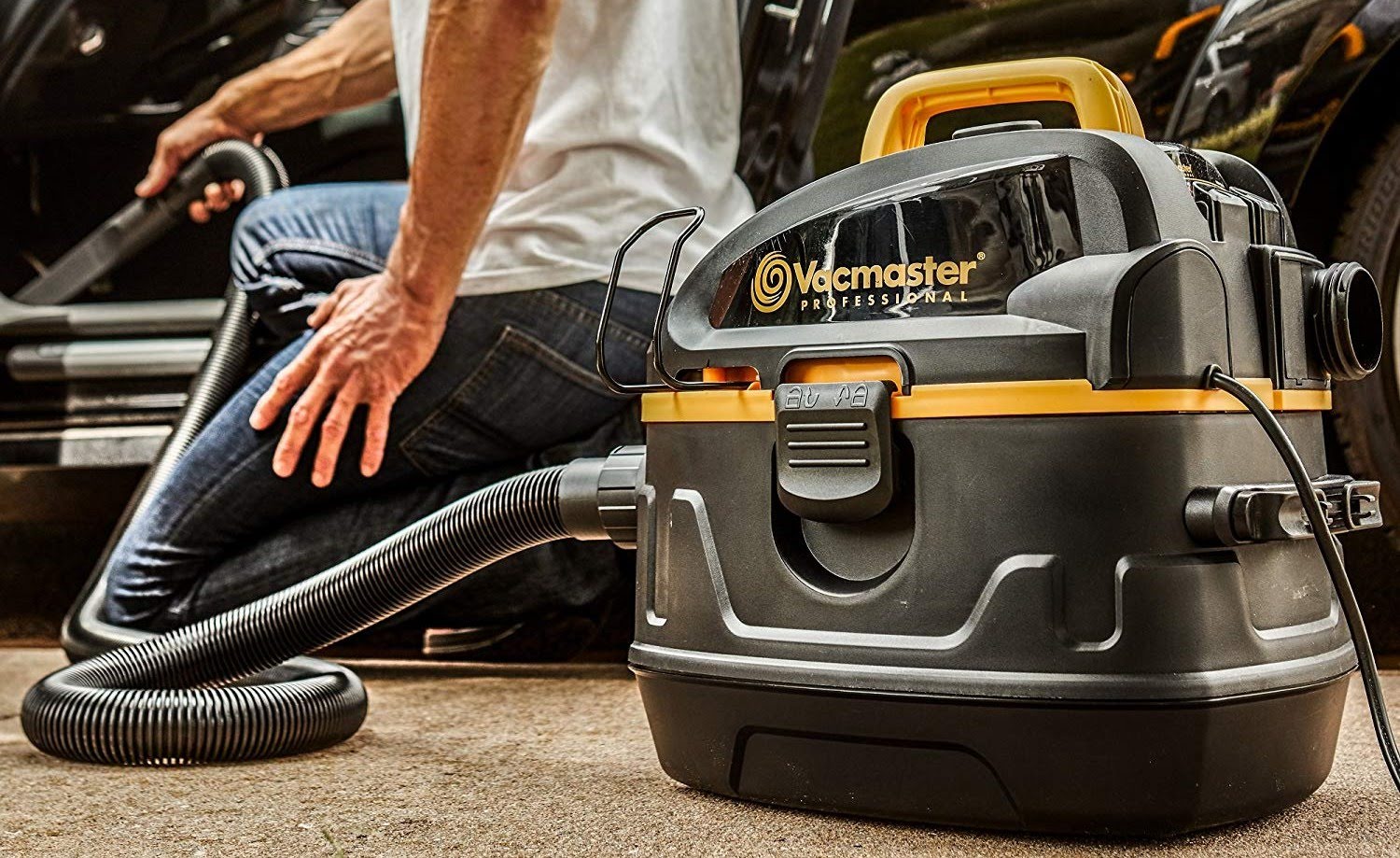
What Can It Be Used For
The main reason to buy a wet-dry vacuum is to clean up messes that might damage your upright vacuum. Whether that may be wet messes or if you need to vacuum up liquid or wet sand, a wet-dry vacuum will be able to handle these without issue. A wet-dry vacuum is ideal for cleaning up messes in the kitchen, bathroom, garage, or for cleaning your car.
One thing to watch out for is that wet-dry vacuums typically don’t filter as well as upright vacuums and some of the dust may make it’s way back into the air. If you’re worried just make sure the vacuum has a good filter. One of the other benefits to wet dry vacuums is that some models can switch between sucking and blowing mode, so it can double as a leaf blower

Why Are Shop-Vacs So Loud?
As shop vacs are designed to deal with industrial dirt and debris, they’re equipped with a powerful motor to allow for this heavy-duty purpose. The motor needs to be strong enough to power the vacuum’s suction. Weak suction just won’t cut it when hoovering up pieces of metal, nails, and wood.
A shop vac’s power comes from the amps and watts delivered its electric motor. This motor then spins a fan (or fans) to produce a low-pressure space inside the vac’s canister, which is attached to a hose. Sealed suction (or water lift) is generated based on the airflow. Inevitably, the sheer power of the motor and the movement of the vac’s various parts will create noise.
How effective the shop vac is in picking up debris is related to the airflow created. This is calculated in cubic feet per minute (CFM). Contrary to what you might think, a larger motor isn’t necessarily more effective than a smaller one. Greater airflow (and therefore better cleaning) is down to the motor and vac’s design rather than mere motor size.
For example, a hose with unrestricted airflow will work more efficiently. If anything is blocking the airflow, the motor will have to work harder, and more noise will be created. Following this reasoning, using a smooth hose rather than a ribbed one will mean the device will make less noise. The only downside to this is that a flat-sided hose is less flexible.
It’s also important to periodically check and make sure that the hose is always free of blockages. Likewise, a near-capacity canister is likely to cause some noise issues as the motor finds itself having to work harder to create more suction.
The type of motor the shop vac uses can also affect its noise levels. The cheaper motor option, AC, is noisier than DC. But any motor will produce some noise. For example, as the motor turns the fan that creates the vac’s suction mechanism, vibrations are produced. And noise is a vibration.
Shop vacs’ motors contain brush bearings. These electrical contacts help to conduct the electrical current from the power source to the motor. They also work to keep the motor aligned as it turns, preventing friction and overheating. However, if a brush bearing is broken or damaged, it can increase the noise created by the appliance. In that case, it’s essential to get them repaired or replaced.
A motor’s bearings reduce friction and allow for smoother rotation. Unfortunately, if dust gets into these bearings or other moving parts of the shop vac, it’ll impair their smooth movement. The result? A high-frequency screeching sound that’ll warn you repairs or parts replacement are needed.
The fan in a shop vac is spun by the motor to create the suction. This mechanism usually makes some noise. But if it’s broken, the generation of airflow will be hindered. This, in turn, will force the motor to work harder, leading to heightened noise levels. A broken fan can also cause friction—again, causing more noise.
As you’ll know from using a household vacuum cleaner, most appliances that use motors and fans to produce airflow and suction create some vibration. And this equals a certain amount of noise. But suppose you sense that these vibrations produced by your shop vac have increased over time. In that case, something could be deflecting the centrifuge of the generated air. It means that the increased vibrations are being caused by more turbulent airflow. Try emptying the vac’s canister and see if that fixes the problem.
So, we’ve established that shop vacs are inevitably going to produce some noise. However, these noise levels can be affected by several factors, including the appliance’s design and any faulty or broken parts. Most of these issues can be fixed through repairs or replacements.
A Decibel Comparison
We’ve established that being more powerful than most other conventional vacuum cleaners, shop vacs will operate louder. But do different models differ in their noise levels? And how loud is loud?
Sound is measured in decibels (dB), and we can look at the decibel levels of some common sounds to find out how quiet or loud particular shop vac models are. A typical conversation averages around 60 dB and a running motorcycle engine at about 95 dB. The Centers for Disease Control and Prevention (CDC) advises against prolonged exposure to any sounds of 70 dB or above.
Shop vacs’ noise levels range from 55db to 65-70 dB. With this in mind, you should be able to find a relatively quiet shop vac that won’t damage your hearing.
However, many manufacturers don’t clearly state the decibel levels of their appliances, making it harder to choose a quieter model. It may be worth checking out consumer reviews to get a more accurate picture.
A Buyer’s Guide to Shop Vacs
Still interested in getting one of these heavy-duty appliances? To filter out the shop vacs that won’t work for you, you’ll need to consider several factors. Let’s take a look at these now.
Decibel Levels
As we’ve discussed, shop vacs can vary in the amount of noise they produce. Suppose you’re looking for a cleaner that needs to be used in a quiet environment (or where wearing protective headphones isn’t an option). In that case, you’ll need to carefully check the device’s decibel level output. Either look at the manufacturer’s guide or online reviews. Opt for a shop vac with the lowest number of decibels.
Tank Size/Capacity
You’re going to want your vac’s tank or canister to have sufficient capacity to deal with the type and amount of dirt and debris you’ll be cleaning up. For use in larger areas or where the size of waste will be bigger, opt for large tank size. For smaller workshops or sites, or where the size of debris is smaller or finer, a smaller tank will suffice. Remember that the larger the tank, the bulkier the device and the harder it may be to empty.
Thickness and Length of Hose
The design of the shop vac’s hose is more important than you might think. As we’ve discussed, a smoother tube without ribbing will reduce noise levels but be less flexible. You also need to check the hose’s diameter as this influences the shop vac’s suction capabilities. The smaller the hose diameter, the greater the suction.
However, too small a diameter and the vac won’t pick up larger pieces of debris and risks becoming clogged. The thickness of the hose can also influence durability—if it’s too thin for the types of cleanups you’re using it for, the higher the risk of it becoming quickly damaged. Too thick, and the more difficult it is to handle. Length also needs to be considered, but you do have the option of using hose extensions if necessary.
A general rule of thumb is that for small debris, such as sawdust or finer particles and liquids, a 1.25-inch hose diameter will do the trick. For cleanups involving woodchips and larger fragments, a medium-sized hose of around 1.5 inches should suffice. With general cleanup tasks involving larger surface areas and bigger pieces of debris, including leaves and pieces of metal, go for a hose with a diameter of around 2.5 inches.
Power
Factoring in the power of a shop vac is essential when deciding which model to purchase. The appliance’s motor output is measured in peak horsepower. The higher the peak horsepower (hp), the greater the suction power—crucial when dealing with heavy-duty waste or spillages. Most powerful shop vacs will have a motor rating of 4-5 hp.
Suction
Determining a shop vac’s peak horsepower gives some indication of its motor power and performance capabilities. However, it won’t accurately show the appliance’s overall suction power.
One way of determining a shop vac’s suction power effectiveness is by checking its Air Power (AP) rating. It’s a good idea to look out for this rating if your cleaning involves vacuuming up screws, bolts, and heavy or oversized waste. The higher the AP, the higher the airflow at the inlet, meaning the higher the suction power.
Also, as mentioned, look out for cubic feet per minute (CFM). This rating shows the appliance’s maximum airflow capacity at its largest opening. Fine debris or dust requires a shop vac with a higher CFM rating.
Additionally, when looking for a shop vac that’ll effectively hoover up liquids, check its sealed pressure rating (or water lift). This rating best indicates the appliance’s suction pressure and is typically measured in inches of water. Shop vacs with a sealed pressure rating of over 75 are considered powerful enough to deal with high volumes of liquids.
Canister/Tank Material
Take into account the type of material that the shop vac’s canister or tank is made from. Certain types of materials will accommodate different types of debris better than others. And some materials are more hard-wearing and durable than others.
Extruded plastic is inexpensive, light-weight, impervious to moisture, flexible, and easy to clean. It tends not to dent or scratch easily.
You’ll pay more for a shop vac with a stainless steel tank. This material also weighs more than plastic. However, it’s more durable than plastic and easier to clean since less static is created inside the tank.
Collection Bags
Whether or not you need to use a collection bag with your shop vac usually depends on the model and what type of debris you’re picking up. A collection bag is placed in the tank, making the emptying and disposal of any waste easier. It also helps prevent the filter on the lid cage from clogging and reduces the frequency at which you’ll have to clean the filter. Always look at the manufacturer’s guide for more information.
Filters
The most basic shop vacs don’t come with any filter; you simply use them to hoover up and collect waste, emptying the tank or canister when you’re done. However, it’s advisable to select an appliance that does come with some type of filter to trap fine dust and prevent particles from being blown back into the room.
The type of filter and its level of filtration will depend upon the type of debris you’ll be using the shop vac on. Cartridge or reusable dry filters are generally used for dry waste. Foam filters (or sleeves) are used for cleanups involving liquids. Filtration levels are measured in fine, medium, or general. For areas involving larger debris, general filtration should suffice.
HEPA filters, also known as high-efficiency particulate absorbing filters, are most effective at trapping harmful particles.
Blowers
For difficult-to-reach areas (such as under equipment) or for leaf blowing, a blower is a handy device to have. It’ll enable you to gather hard-to-reach debris in one place before vacuuming it up. Most shop vacs can be easily converted into blowers to complete such tasks.
Portability
Ease of lifting, moving, and carrying is another essential consideration when purchasing a shop vac. The larger the vacuum, the less portability due to its weight and bulk. Many shop vacs come with the option of wheels for maneuverability to solve this issue. But you also have to consider how easy and convenient it’ll be to empty the canister and move the device from site to site.
Selecting a cordless shop vac will also mean you won’t have to limit your cleaning range. This is especially useful for larger areas where power outlets are limited or for outside spaces.
Shop-Vac Accessories
You’ve got your basic shop vac; you can use it to vacuum up debris or use it as a blower. But there’s also the option of purchasing accessories to customize and enhance your cleaning experience. These accessories include hoses, nozzles, extension wands, adapters, filters, and more. They’re a convenient way to modify and adapt your existing shop vac to suit particular cleaning tasks.
Warranty
When searching for the right shop vac, it’s also worth looking at the warranties different retailers and manufacturers offer. This will cover you if your appliance breaks and needs repairs or replacement parts—the longer the warranty, the better. A five-year warranty is ideal, but not all manufacturers are willing to offer this. You may even want to take out an extended one if you’re paying extra for a high-end appliance that you’ll often be using.
Different Types of Shop Vacs
We’ve checked out the features of basic shop vacs. Now let’s take a look at other varieties available on the market today. Different models come in a variety of designs and materials, depending on their function and purpose. You must pick a suitable shop vac for your particular needs and requirements.
Wet/Dry
Working in an environment that involves both wet and dry debris? Then a wet/dry shop vac will serve as a dual-purpose vacuum. You won’t have to worry about using separate appliances for different messes.
Wall Mountable
As its name suggests, a wall-mounted shop vac and its attachments and accessories can be stored off the ground on a wall. This is particularly useful in areas where space is at a premium. These vacuums’ waste canisters are located in their base.
Cordless/Portable
Rather than being hooked up to a power outlet, a cordless or portable shop vac uses an internal or external rechargeable battery. Although convenient in many ways, they’re usually smaller and have a limited operating time.

Price Range
With most things, it’s better to buy at a price other than the cheapest available option, and wet-dry vacuums are no exception. Buy a model that you can have faith in to last you a decade or more. The last thing anyone wants is to have to buy a replacement for a tool that should have been permanent.
The good thing about wet dry vacuums is that they are not particularly expensive. Quality models can be purchased for under $100, and most vacuums above that price point are guaranteed to be good buys. Just make sure you read our reviews first to know what you’re getting into.
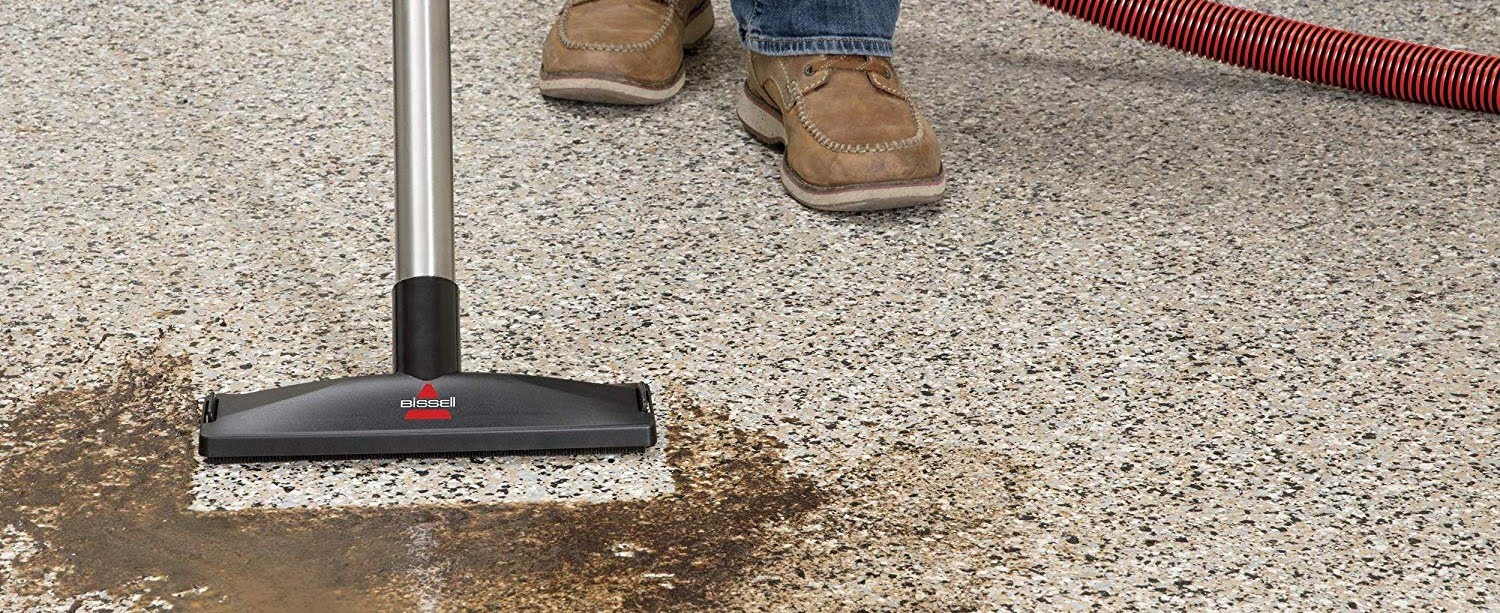
Related Post: Best Wet/Dry Handheld Vacs
The Best Fit
Now that we’ve provided an overview of some of the different factors at play with choosing your ideal wet-dry vacuum, take a look at some of the reviews we’ve curated to help you find the quietest wet dry vacuum on the market today.
Just keep in mind that the general rule of thumb with wet-dry vacuums is that the bigger they are, the more powerful, and as a result the noisier they are. If you have a lot of heavy-duty cleaning that you’ll be using it for, you may need the stronger option. If it’s just typical household cleaning, car, and garage use, then a model with 5 or 6 HP should be fine.
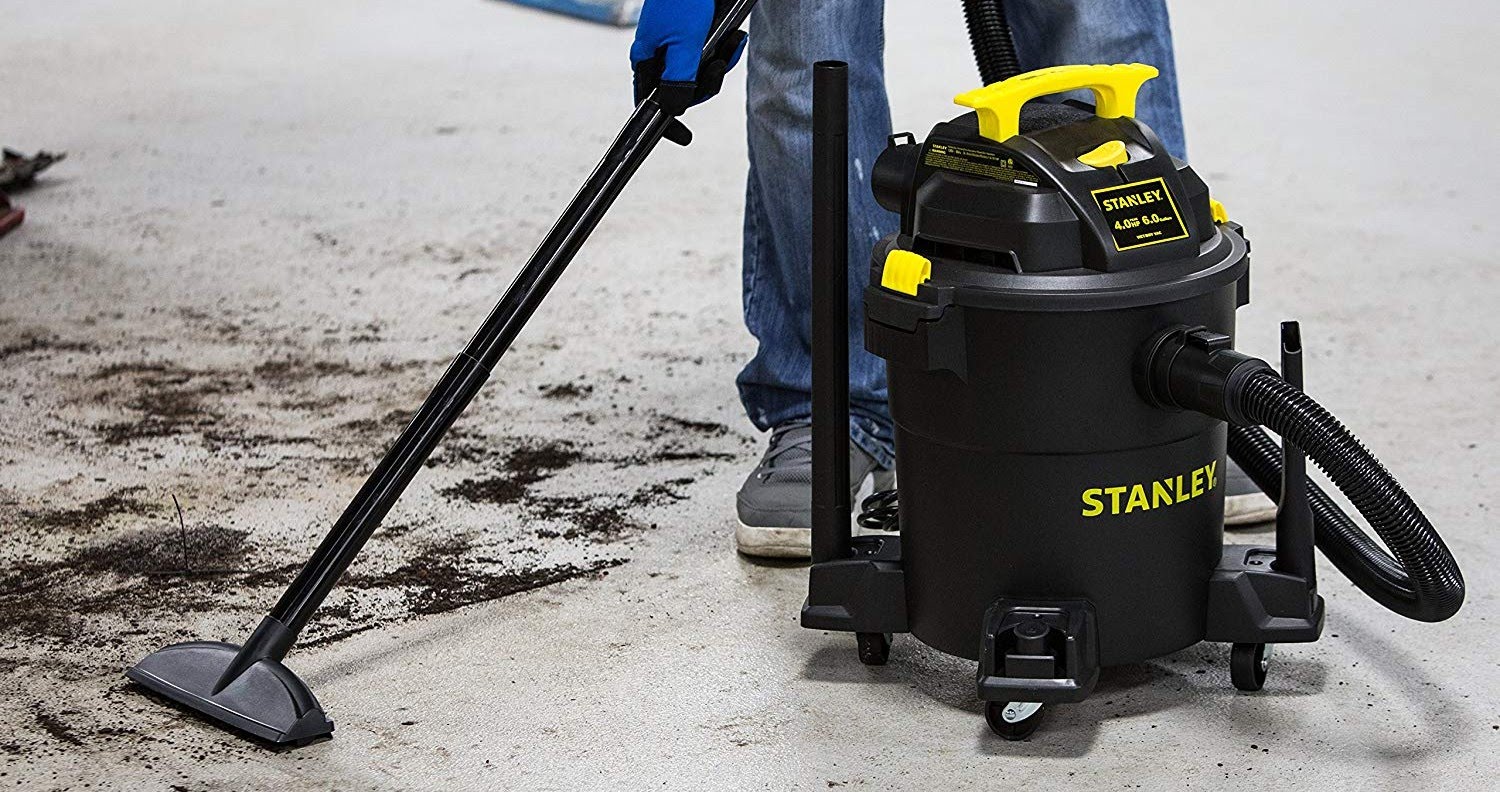
Frequently Asked Questions
Still unsure about shop vacs or which one to choose? These answers to some common questions should help leave your doubts in the dust.
Can I make a Shop Vac quieter?
If your shop vac is too loud for your liking, there are several ways to reduce the sound it makes. One method is muffling the air outlet. You can either make a muffler by cutting and customizing a piece of cloth or purchase one inexpensively. Another option is constructing a sound enclosure—essentially a box to place your shop vac in. This involves a bit more work, and you’ll have to make sure to leave holes for the hose and ventilation.
If you don’t carry out basic cleaning and upkeep of your shop vac, it’ll tend to make more noise. For example, a dirty fan will almost always create noise. Always check to make sure that the hose isn’t clogged, the canister isn’t full, and that the filters are cleaned or changed regularly. Any broken or defective parts will have an impact on your appliance’s noise levels.
If you can, covering hard flooring with soft materials, such as cork mats or foam, should absorb some of the noise your vacuum makes. Additionally, using a longer hose means you’ll be further away from the noise of the motor as you clean.
If all else fails, you can purchase noise-canceling headphones (although this may not always be appropriate in some workspaces or environments).
Can I use a regular vacuum cleaner instead of a shop vac?
This depends entirely on the space you want to clean. One of the main differences between conventional vacuum cleaners and shop vacs is that the latter deals with heavy-duty debris and spillages. If you need to hoover up nails, wood chips, glass, and liquids, an everyday vacuum cleaner simply won’t be up to the job. Shop vacs are more powerful and have a larger debris-collection capacity. Conventional vacuum cleaners are best suited to smaller areas with smaller amounts of dust, dirt, and particles, such as offices or households.
Can I use a shop vac without a filter?
In theory, you can use your shop vac without a filter. In practice, it’s not a great idea. You’ll find that a lot of the debris you vacuum up gets blown back out. Plus, in the long run, it’ll shorten your device’s lifespan. Always use the correct type of filter for the kind of debris or liquids you’ll be using your short vac on.
Final Thoughts
A shop vac plays a vital role in the cleaning and upkeep of an industrial or construction workshop or site. Built and designed to handle large areas containing heavy-duty debris and spillages, they cut down the time and energy needed to clean and clear a workspace. They’re essential in contributing to a dirt-free, safe, and hazard-free work environment.
To get the very best out of a shop vac, it’s essential to pick the most appropriate one for your specific space.
If you bear in mind all the points we’ve laid out in this article, you’ll avoid making any mistakes when making your purchase. Plus, with the correct upkeep and maintenance, including the appropriate use of filters and accessories, your shop vac will be a trusted cleaning appliance for years to come.
If you have any questions or comments, please add them below in the comment section. Similarly, please let us know if you spot any mistakes or omissions. Thanks!
Last Update: 2024-05-01 | Affiliate links/Images from Amazon Product Advertising API




